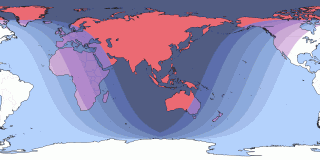Jan 1, 2029 at 12:11 am
Max View in 66°10'04.2"S, 103°13'52.7"E
| Global Event: | Total Lunar Eclipse |
|---|---|
| Local Type: | Total Lunar Eclipse, in 66°10'04.2"S, 103°13'52.7"E |
| Begins: | Sun, Dec 31, 2028 at 11:29 pm |
| Maximum: | Mon, Jan 1, 2029 at 12:11 am 1.161 Magnitude |
| Ends: | Mon, Jan 1, 2029 at 1:02 am |
| Duration: | 1 hour, 33 minutes | All times shown on this page are local time. |
Eclipses and Transits Visible in 66°10'04.2"S, 103°13'52.7"E
| Eclipse Visibility From 66°10'04.2"S, 103°13'52.7"E | Visibility Worldwide | ||
|---|---|---|---|
| Sep 7–8, 2025 Total Lunar Eclipse | Total Lunar Eclipse |  | |
| Feb 17, 2026 Partial Solar Eclipse | Annular Solar Eclipse |  | |
| Mar 3, 2026 Partial Lunar Eclipse | Total Lunar Eclipse |  | |
| Feb 21, 2027 Penumbral Lunar Eclipse | Penumbral Lunar Eclipse |  | |
| Jul 6–7, 2028 Partial Lunar Eclipse | Partial Lunar Eclipse |  | Note: Click on the date link for details in 66°10'04.2"S, 103°13'52.7"E, or the path map image for global details. |
